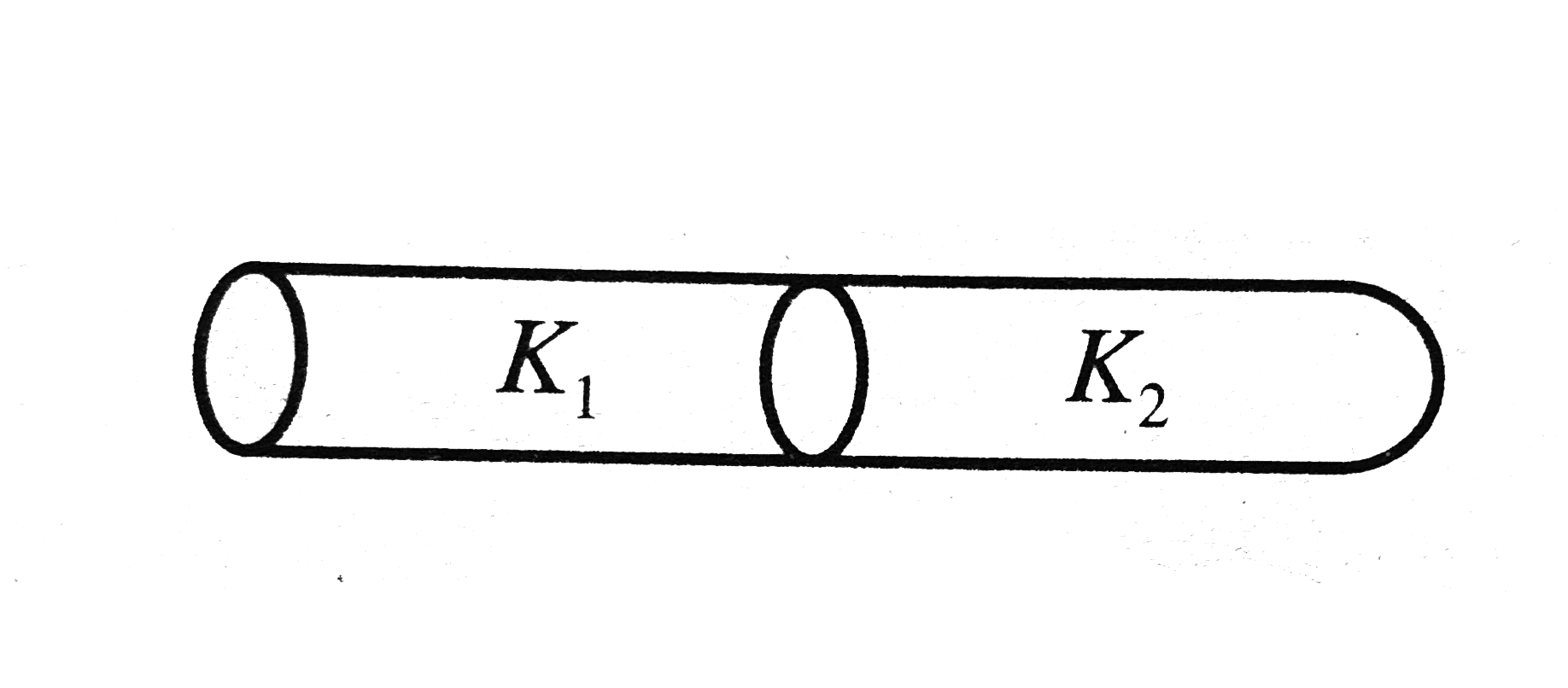Three rods of same dimension are joined in series having thermal conductivity k1 , k2 and k3. The equivalent thermal conductivity is
k1k2k3/k2k3+k1k2+k1k3
3(k1k2k3)/k2k3+k1k2+k1k3
k1+k2+k3
(k1+k2+k3)/ 3
The correct Answer is:B
To find the equivalent thermal conductivity of three rods joined in series with thermal conductivities k1, k2, and k3, we can follow these steps:
Step 1: Understand the Concept of Thermal Resistance
Thermal resistance R for a rod can be defined as:
R=LkA
where:
- L is the length of the rod,
- k is the thermal conductivity,
- A is the cross-sectional area.
Step 2: Calculate Individual Resistances
For each rod, the thermal resistance can be expressed as:
- For rod 1: R1=Lk1A
- For rod 2: R2=Lk2A
- For rod 3: R3=Lk3A
Step 3: Find Total Resistance in Series
When these rods are connected in series, the total thermal resistance Rnet is the sum of the individual resistances:
Rnet=R1+R2+R3=Lk1A+Lk2A+Lk3A
Step 4: Simplify the Total Resistance
Factoring out LA:
Rnet=LA(1k1+1k2+1k3)
Step 5: Relate Total Resistance to Equivalent Conductivity
The equivalent thermal resistance can also be expressed in terms of the equivalent thermal conductivity k′:
Rnet=Lk′A
Step 6: Set the Two Expressions for Resistance Equal
Setting the two expressions for Rnet equal gives:
Lk′A=LA(1k1+1k2+1k3)
Step 7: Cancel Common Terms
Cancel LA from both sides:
1k′=1k1+1k2+1k3
Step 8: Solve for Equivalent Conductivity
Taking the reciprocal gives us the equivalent thermal conductivity:
k′=1(1k1+1k2+1k3)
Step 9: Find a Common Denominator
To express this in a more usable form, we can find a common denominator:
k′=k1k2k3k2k3+k3k1+k1k2
Final Answer
Thus, the equivalent thermal conductivity k′ for the three rods in series is:
k′=3k1k2k3k1k2+k2k3+k3k1
Thermal resistance R for a rod can be defined as:
R=LkA
where:
- L is the length of the rod,
- k is the thermal conductivity,
- A is the cross-sectional area.
For each rod, the thermal resistance can be expressed as:
- For rod 1: R1=Lk1A
- For rod 2: R2=Lk2A
- For rod 3: R3=Lk3A
When these rods are connected in series, the total thermal resistance Rnet is the sum of the individual resistances:
Rnet=R1+R2+R3=Lk1A+Lk2A+Lk3A
Factoring out LA:
Rnet=LA(1k1+1k2+1k3)
The equivalent thermal resistance can also be expressed in terms of the equivalent thermal conductivity k′:
Rnet=Lk′A
Setting the two expressions for Rnet equal gives:
Lk′A=LA(1k1+1k2+1k3)
Cancel LA from both sides:
1k′=1k1+1k2+1k3
Taking the reciprocal gives us the equivalent thermal conductivity:
k′=1(1k1+1k2+1k3)
To express this in a more usable form, we can find a common denominator:
k′=k1k2k3k2k3+k3k1+k1k2
Thus, the equivalent thermal conductivity k′ for the three rods in series is:
k′=3k1k2k3k1k2+k2k3+k3k1
Topper's Solved these Questions
Similar Questions

Statement I: Two solid cylindrical rods of identical size and different thermal conductivity K1 and K2 are connected in series. Then the equivalent thermal conductivity of two rods system is less than that value of thermal conductivity of either rod.
Statement II: For two cylindrical rods of identical size and different thermal conductivity K1 and K2 connected in series, the equivalent thermal conductivity K is given by 2K=1K1+1K2
View Solution
Statement I: Two solid cylindrical rods of identical size and different thermal conductivity K1 and K2 are connected in series. Then the equivalent thermal conductivity of two rods system is less than that value of thermal conductivity of either rod.
Statement II: For two cylindrical rods of identical size and different thermal conductivity K1 and K2 connected in series, the equivalent thermal conductivity K is given by 2K=1K1+1K2
View Solution
Knowledge Check
Consider a compound slab consisting of two different material having equal thickness and thermal conductivities K and 2K respectively. The equivalent thermal conductivity of the slab is
A23KB√2KC3KD43K
A slab consists of two layers of different materials of the same thickness and having thermal conductivities K1 and K2. The equivalent thermal conductivity of the slab is
View Solution
Three rods of same dimensions are arranged as shown in Fig. They have thermal conductivities K1,K2 and K3. The points P and Q are maintained at different temeperature for the heat to flow at the same rate along PRQ and PQ. Whi of the following options correct?
View SolutionThe thermal conductivity of a rod depends on
View SolutionThe thermal conductivity of a rod depends on
View SolutionThe thermal conductivity of a rod depends on
View SolutionConsider a compound slab consisting of two different material having equal thickness and thermal conductivities K and 2K respectively. The equivalent thermal conductivity of the slab is
View SolutionA composite slab is made of two parallel layers of two different materials of thermal conductivities K1andK2 are of same thickness. Show that the equivalent thermal conductivity of the slab is 2K1K2K1+K2
View Solution
